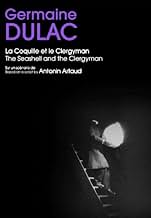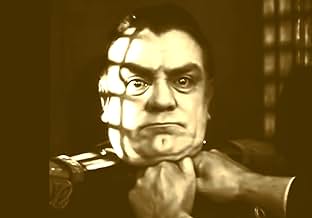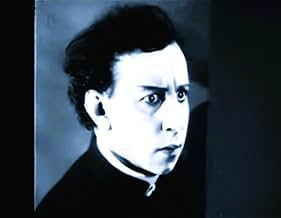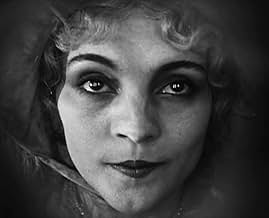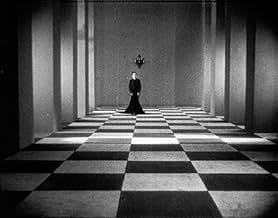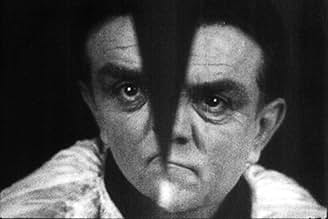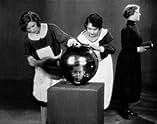AVALIAÇÃO DA IMDb
7,0/10
2,4 mil
SUA AVALIAÇÃO
Adicionar um enredo no seu idiomaObsessed with a general's woman, a clergyman has strange visions of death and lust, struggling against his own eroticism.Obsessed with a general's woman, a clergyman has strange visions of death and lust, struggling against his own eroticism.Obsessed with a general's woman, a clergyman has strange visions of death and lust, struggling against his own eroticism.
- Direção
- Roteiristas
- Artistas
- Direção
- Roteiristas
- Elenco e equipe completos
- Produção, bilheteria e muito mais no IMDbPro
Avaliações em destaque
If you are looking for a twin movie to go alongside Luis Buñuel's surrealist head-scratcher Un Chien Andalou, then look no further than this film. The Seashell and the Clergyman shares that famous movie's bizarre, often indecipherable, imagery as well as anti-clerical subversion and frank sexuality. I can't say I understood what was going on. I'm not sure if I was even supposed to. But like Buñuel's film this movie is all about surrealism, it doesn't always have logical meaning. An image such as the clergyman crawling through the streets of Paris is something that is not easily forgotten and the film in general operates in the same way as a dream. The best way to appreciate a film such as this is to sit back and take in the imaginative visuals and dream-like ambiance that is specific to these ancient silent movies. If you are at all interested in 20's surrealist cinema then this is a film I would definitely recommend. Also, the fact that a woman made such a provocative film all those years ago is especially surprising seeing as female artists have always struggled with having their voice heard.
Germaine Dulac was no ordinary French female film-director. She was Avante-Garde and radical in her film-making which did not include a laugh track or sound. Everything was visual and her silent classics were visuals to be appreciated and understood by all of us. There was a reason that so many people saw the same movie numerous times during that era. First, it was very inexpensive and second, you needed to revisit and see the film again and again until you saw it completely. That's how films once were, films were visual masterpieces and in Dulac's case, she helped reshape the role of women in films to include more than just being an actress. She was the producer, director, and writer. She was many things to many people on film sets in France. Film was new and fresh invention that those of us who seek to learn more about art should watch Dulac's classic.
The predecessor of Un Chien Andalou and directed by the lone woman filmmaker of her time, La Coquille et le Clergyman is one of the most celebrated of French avant-garde movies of the '20s, partly because Antonin Artaud wrote the script, partly because the British censor of the time banned it with the legendary words 'If this film has a meaning, it is doubtless objectionable'. Artaud was reputedly unhappy with Dulac's realization of his scenario, and it's true that the story's anti-clericalism (a priest develops a lustful passion that plunges him into bizarre fantasies) is somewhat undermined by the director's determined visual lyricism. But the fragmentation of the narrative and the innovative imagery remain provocative, and the film is of course fascinating testimony to the currents of its time.
Obsessed with a general's woman (Genica Athanasiou), a clergyman (Alex Allin) has strange visions of death and lust, struggling against his own eroticism.
"Un chien andalou" is considered the first surrealist film, but its foundations in "The Seashell and the Clergyman" have been all but overlooked. However, the iconic techniques associated with surrealist cinema are all borrowed from this early film. Conversely, Alan Williams has suggested the film is better thought of as a work of or influenced by German expressionism.
I think this is why I absolutely adore this film. I'm enamored with German expressionism, and I love surreal film. This is the two combined, and the acting is superb. Anyone who loves "Un chien" really needs to check this one out.
"Un chien andalou" is considered the first surrealist film, but its foundations in "The Seashell and the Clergyman" have been all but overlooked. However, the iconic techniques associated with surrealist cinema are all borrowed from this early film. Conversely, Alan Williams has suggested the film is better thought of as a work of or influenced by German expressionism.
I think this is why I absolutely adore this film. I'm enamored with German expressionism, and I love surreal film. This is the two combined, and the acting is superb. Anyone who loves "Un chien" really needs to check this one out.
It is maybe the most accurate depiction of dreams as I experience them that I have seen on film. It gets things right like the gradual construction of images when for example a building keeps changing shape (through dissolves between different buildings that were photographed similarly) before it finds its "final" shape (nothing is final in dreams), or an empty sea becomes a sea with a pier and a ship in it, or the other way around people, for example, dissolve into thin air while the surroundings stay the same. There is an inexplicable obsession with certain objects, but those objects aren't just part of some symbolic decoration without function, they are handled personally by the dreamer (the clergyman), almost as if objects that the dreamer doesn't touch also don't exist.
The dreamer goes through repetitive tasks like opening a door to walk trough a corridor to open a door to walk through a corridor to open...until new images are found to progress the dream. The clergyman is always driven. Even when it looks like he might be in charge of the moment his behavior feels compulsive, like filling one glass after another with a liquid and then letting the glass shatter on the floor again and again like on a loop. None of the other characters quite seem to have an own will either but the clergyman especially kind of seems like he is hypnotized throughout it.
There's also a lot of running here. Running away from something becomes a chasing after something. We see the person that the dreamer chases after but when we see the dreamer there is nobody in front of him. The person is still there and the chase continues, the person just isn't necessarily always visible, that the person's presence is felt is the real confirmation of the person being there.
We have our clergyman crawling towards an exit, in the next shot he crawls through the streets of Paris, then it cuts to some shots of the road obviously taken from a driving car, then a shot of him crawling around a corner, back to a shot of the road, then he runs around a corner, then another corner, and another,...
A rewatch confirmed that there is no film like it. Also that it makes no sense and that for me it doesn't say anything. Usually I wouldn't care all that much for such a film, yet I found it not just compelling but it's maybe also the first time that I'd call a film hypnotic. So here I am with this film feeling that for me it warrants not just a good score but full marks.
Despite the lack of sense and meaning and also the fact that you can never predict what shot you might see next, there is no confusion whatsoever in it. There are no scenes in the conventional sense, nor a story per se, just a constant flow of images with an intuitive progression that I always found very easy to follow. The definition of dream logic? I think so.
Like in a dream there are objects and actions that can be read as symbolic in retrospect in an attempt to make sense of it, but unlike so many other dream-like films nothing here feels symbolic. As far as I can tell it doesn't want you to figure out what it means or if it means anything at all. Nor do I think does it try to provoke, shock or amuse. According to the documentary about "The Seashell", called "Surimpressions", it is less concerned with the representation of a dream than with the "construction of its mental space-time, made of images of the world, in the world, transformed by the resources of cinema". Works for me.
The avant-garde "score for twelve instruments" of the 2005 Arte restoration (41 minutes in length) by a certain Iris ter Schiphorst, fits the film superbly. To quote NRC Handelsblad, 7 April 2005: "The music of the Dutch/German composer Iris ter Schiphorst related to the film quite naturally... a genuine unity of image and music. Sometimes it follows the associations very precisely, sometimes it takes its own path. Ter Schiphorst manages to elicit a very individual sound from the instruments: thin and unreal." "The Seashell" has a lot of varied camera tricks and optical effects but in most avant-garde films it feels like the trick came first, function follows form. Here, without anything making any logical sense, the trickery still feels like a means to an end, an end that is more than just delivering original and beautiful images. That the score isn't exactly comfortable and just as unpredictable as the images yet doesn't upstage them perhaps speaks for their strength.
The dreamer goes through repetitive tasks like opening a door to walk trough a corridor to open a door to walk through a corridor to open...until new images are found to progress the dream. The clergyman is always driven. Even when it looks like he might be in charge of the moment his behavior feels compulsive, like filling one glass after another with a liquid and then letting the glass shatter on the floor again and again like on a loop. None of the other characters quite seem to have an own will either but the clergyman especially kind of seems like he is hypnotized throughout it.
There's also a lot of running here. Running away from something becomes a chasing after something. We see the person that the dreamer chases after but when we see the dreamer there is nobody in front of him. The person is still there and the chase continues, the person just isn't necessarily always visible, that the person's presence is felt is the real confirmation of the person being there.
We have our clergyman crawling towards an exit, in the next shot he crawls through the streets of Paris, then it cuts to some shots of the road obviously taken from a driving car, then a shot of him crawling around a corner, back to a shot of the road, then he runs around a corner, then another corner, and another,...
A rewatch confirmed that there is no film like it. Also that it makes no sense and that for me it doesn't say anything. Usually I wouldn't care all that much for such a film, yet I found it not just compelling but it's maybe also the first time that I'd call a film hypnotic. So here I am with this film feeling that for me it warrants not just a good score but full marks.
Despite the lack of sense and meaning and also the fact that you can never predict what shot you might see next, there is no confusion whatsoever in it. There are no scenes in the conventional sense, nor a story per se, just a constant flow of images with an intuitive progression that I always found very easy to follow. The definition of dream logic? I think so.
Like in a dream there are objects and actions that can be read as symbolic in retrospect in an attempt to make sense of it, but unlike so many other dream-like films nothing here feels symbolic. As far as I can tell it doesn't want you to figure out what it means or if it means anything at all. Nor do I think does it try to provoke, shock or amuse. According to the documentary about "The Seashell", called "Surimpressions", it is less concerned with the representation of a dream than with the "construction of its mental space-time, made of images of the world, in the world, transformed by the resources of cinema". Works for me.
The avant-garde "score for twelve instruments" of the 2005 Arte restoration (41 minutes in length) by a certain Iris ter Schiphorst, fits the film superbly. To quote NRC Handelsblad, 7 April 2005: "The music of the Dutch/German composer Iris ter Schiphorst related to the film quite naturally... a genuine unity of image and music. Sometimes it follows the associations very precisely, sometimes it takes its own path. Ter Schiphorst manages to elicit a very individual sound from the instruments: thin and unreal." "The Seashell" has a lot of varied camera tricks and optical effects but in most avant-garde films it feels like the trick came first, function follows form. Here, without anything making any logical sense, the trickery still feels like a means to an end, an end that is more than just delivering original and beautiful images. That the score isn't exactly comfortable and just as unpredictable as the images yet doesn't upstage them perhaps speaks for their strength.
Você sabia?
- CuriosidadesThe British Board of Film Censors banned this film in the UK in 1927, saying, "This film is so obscure as to have no apparent meaning. If there is a meaning, it is doubtless objectionable."
- ConexõesEdited into Women Who Made the Movies (1992)
Principais escolhas
Faça login para avaliar e ver a lista de recomendações personalizadas
Detalhes
- Data de lançamento
- País de origem
- Central de atendimento oficial
- Idioma
- Também conhecido como
- The Seashell and the Clergyman
- Locações de filme
- Empresa de produção
- Consulte mais créditos da empresa na IMDbPro
- Tempo de duração
- 40 min
- Cor
- Mixagem de som
- Proporção
- 1.33 : 1
Contribua para esta página
Sugerir uma alteração ou adicionar conteúdo ausente

